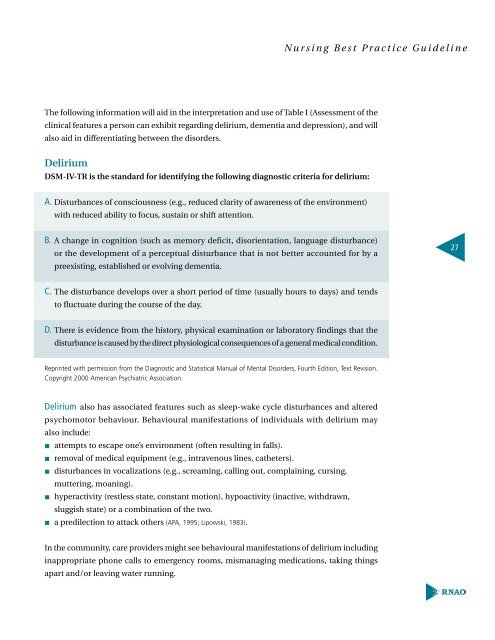Screening for Delirium, Dementia and Depression in Older Adults
Screening for Delirium, Dementia and Depression in Older Adults
Screening for Delirium, Dementia and Depression in Older Adults
- No tags were found...
You also want an ePaper? Increase the reach of your titles
YUMPU automatically turns print PDFs into web optimized ePapers that Google loves.
Nurs<strong>in</strong>g Best Practice Guidel<strong>in</strong>eThe follow<strong>in</strong>g <strong>in</strong><strong>for</strong>mation will aid <strong>in</strong> the <strong>in</strong>terpretation <strong>and</strong> use of Table I (Assessment of thecl<strong>in</strong>ical features a person can exhibit regard<strong>in</strong>g delirium, dementia <strong>and</strong> depression), <strong>and</strong> willalso aid <strong>in</strong> differentiat<strong>in</strong>g between the disorders.<strong>Delirium</strong>DSM-IV-TR is the st<strong>and</strong>ard <strong>for</strong> identify<strong>in</strong>g the follow<strong>in</strong>g diagnostic criteria <strong>for</strong> delirium:A. Disturbances of consciousness (e.g., reduced clarity of awareness of the environment)with reduced ability to focus, susta<strong>in</strong> or shift attention.B. A change <strong>in</strong> cognition (such as memory deficit, disorientation, language disturbance)or the development of a perceptual disturbance that is not better accounted <strong>for</strong> by apreexist<strong>in</strong>g, established or evolv<strong>in</strong>g dementia.27C. The disturbance develops over a short period of time (usually hours to days) <strong>and</strong> tendsto fluctuate dur<strong>in</strong>g the course of the day.D. There is evidence from the history, physical exam<strong>in</strong>ation or laboratory f<strong>in</strong>d<strong>in</strong>gs that thedisturbance is caused by the direct physiological consequences of a general medical condition.Repr<strong>in</strong>ted with permission from the Diagnostic <strong>and</strong> Statistical Manual of Mental Disorders, Fourth Edition, Text Revision.Copyright 2000 American Psychiatric Association.<strong>Delirium</strong> also has associated features such as sleep-wake cycle disturbances <strong>and</strong> alteredpsychomotor behaviour. Behavioural manifestations of <strong>in</strong>dividuals with delirium mayalso <strong>in</strong>clude: attempts to escape one’s environment (often result<strong>in</strong>g <strong>in</strong> falls). removal of medical equipment (e.g., <strong>in</strong>travenous l<strong>in</strong>es, catheters). disturbances <strong>in</strong> vocalizations (e.g., scream<strong>in</strong>g, call<strong>in</strong>g out, compla<strong>in</strong><strong>in</strong>g, curs<strong>in</strong>g,mutter<strong>in</strong>g, moan<strong>in</strong>g). hyperactivity (restless state, constant motion), hypoactivity (<strong>in</strong>active, withdrawn,sluggish state) or a comb<strong>in</strong>ation of the two. a predilection to attack others (APA, 1995; Lipowski, 1983).In the community, care providers might see behavioural manifestations of delirium <strong>in</strong>clud<strong>in</strong>g<strong>in</strong>appropriate phone calls to emergency rooms, mismanag<strong>in</strong>g medications, tak<strong>in</strong>g th<strong>in</strong>gsapart <strong>and</strong>/or leav<strong>in</strong>g water runn<strong>in</strong>g.
















